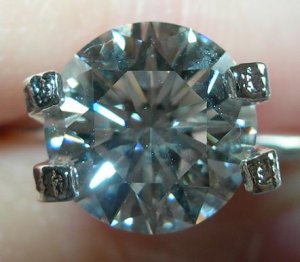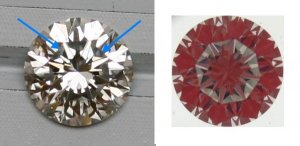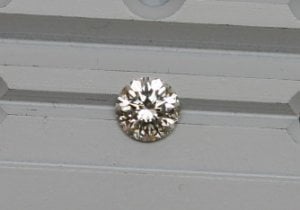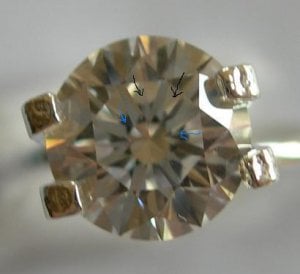rogue
Shiny_Rock
- Joined
- Jul 15, 2006
- Messages
- 180
LMAO!!! those last two are great, but this one is hilarious... *someone* has to love this stone... might as well be you, you''ve already named it! LOL!!!!Date: 7/21/2006 9:45:12 AM
Author: rogue
Spot smiling...
::sings off-key:: How much is that puppy in the window? The one with the spot on its nose... How much is that puppy in the window, I sure hope that puppy''s for sale... I swear that ''smile'' picture is calling you! LOLDate: 7/21/2006 9:45:12 AM
Author: rogue
Spot smiling...
Hi Rhino, I wouldn''t say it was *easily* discernable, but in comparison to a stone with a shallower pavilion angle, with both stones held inside a plastic case with a black spongy backing, you could notice the ring of death in most lighting. Even without a comparison, I could notice it in a dark conference room with a faint flourescent lighting source about 10 feet away -- it seemed to be most noticeable in those conditions. I looked at it most of the time with the light blocked from the pavilion (as it was in the black case). With both stones in the high temporary tension setting, however, it was not very noticeable anywhere but that conference room.






Great example Rhino.Date: 8/5/2006 6:09:52 PM
Author: Rhino
I appreciate your commentary rogue. More than you know. Interestingly light leakage is enhanced against a black background so your comment doesn't surprise me there. It's your other comments that catch my interest in more normal viewing conditions. Attached is a picture I have here that is a GIA Very Good because of a deterioration in appearance (brightness) due to a visible ring of death. This first shot is a macro shot taken in diffuse daylight that is magnified with its accompanying DiamXray image and I'm pointing to the dull areas caused by the leakage with the blue arrows. It is this phenomena that I was curious to know if you saw or not in that stone, not against the black.
The next shot is scaled down more to size. Thank you kindly for this feedback rogue. I'm getting a couple of stones in my inventory recut and this was a proportion combination we have not received yet for our study.
Best regards and once again ... CONGRATS on your upcoming engagement.
Jonathan

Yes Pyramid, they are the darkness of the camera lens.Date: 8/6/2006 5:01:48 AM
Author: Pyramid
Are the dark areas which Rogue refers to not head shaddow rather than ring of death?
Awesome. LOL... spots of death are actually reflections off the pavilion that are reflecting back the camera lens. Those dark spots are fine as long as the balance of those don''t fall too much in the direction making the stone too dark which generally results from shallow angled diamonds. When pavilion/crown combo''s fall too much on the shallow side then you get too much darkness (not because of leakage) but facets reflecting back things obstructing light.Date: 8/5/2006 9:30:20 PM
Author: rogue
Great pictures Rhino--I think this could be a very useful post to have in the archives, and your video sounds like it will be invaluable. I don''t think I saw anything nearly that bad in the stone I had. Even against the black background, it wasn''t that pronounced. As seen in the pictures I posted, I think I recognized the darkness directly around the table reflection--very close to where the arrows originate--rather than the more outward areas you point to in your picture. From what I remember, even that darkness (perhaps, the spots of death?), was not that noticeable except in that low light conference room when I blocked the pavilion with my fingers.
Yep.I was concerned about that stone not because of the ring of death per se, but because of what its presence might mean for the stone''s light return and optical performance capacity in general, even in those circumstances in which I would not be able to see the ROD. I was afraid that the simple presence of the ROD would mean that the stone would just not have the capability to be as brilliant or would not scintillate as much (even though I didn''t really see a difference with my non-mathematical naked eye). Do you think that''s a reasonable concern to have? Would that only apply if, say, the pavilion is dirty and you have effectively created a black backdrop?


